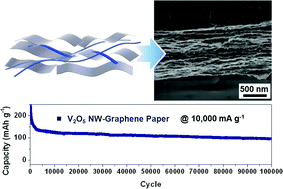Extremely stable cycling of ultra-thin V2O5nanowire–graphene electrodes for lithium rechargeable battery cathodes†
Abstract

* Corresponding authors
a
Department of Materials Science and Engineering and KAIST Institutes NanoCentury, KAIST, 291 Daehak-ro, Yuseong Gu, Daejeon 305-701, Republic of Korea
E-mail:
jeungku@kaist.ac.kr
Fax: +82-42-350-3310
Tel: +82-42-350-3338
b
Graduate School of EEWS (WCU) and KAIST Institutes NanoCentury, KAIST, 291 Daehak-ro, Yuseong Gu, Daejeon 305-701, Republic of Korea
E-mail:
jangwookchoi@kaist.ac.kr
Fax: +82-42-350-2248
Tel: +82-42-350-1719

 Please wait while we load your content...
Something went wrong. Try again?
Please wait while we load your content...
Something went wrong. Try again?
J. W. Lee, S. Y. Lim, H. M. Jeong, T. H. Hwang, J. K. Kang and J. W. Choi, Energy Environ. Sci., 2012, 5, 9889 DOI: 10.1039/C2EE22004K
To request permission to reproduce material from this article, please go to the Copyright Clearance Center request page.
If you are an author contributing to an RSC publication, you do not need to request permission provided correct acknowledgement is given.
If you are the author of this article, you do not need to request permission to reproduce figures and diagrams provided correct acknowledgement is given. If you want to reproduce the whole article in a third-party publication (excluding your thesis/dissertation for which permission is not required) please go to the Copyright Clearance Center request page.
Read more about how to correctly acknowledge RSC content.
 Fetching data from CrossRef.
Fetching data from CrossRef.
This may take some time to load.
Loading related content
